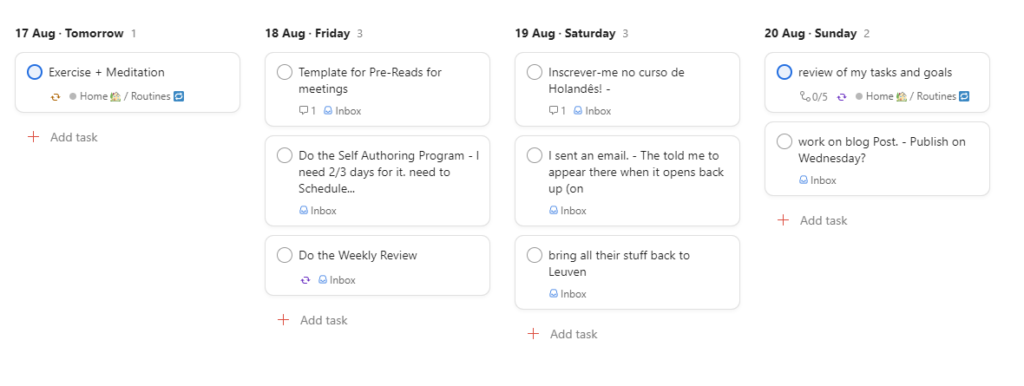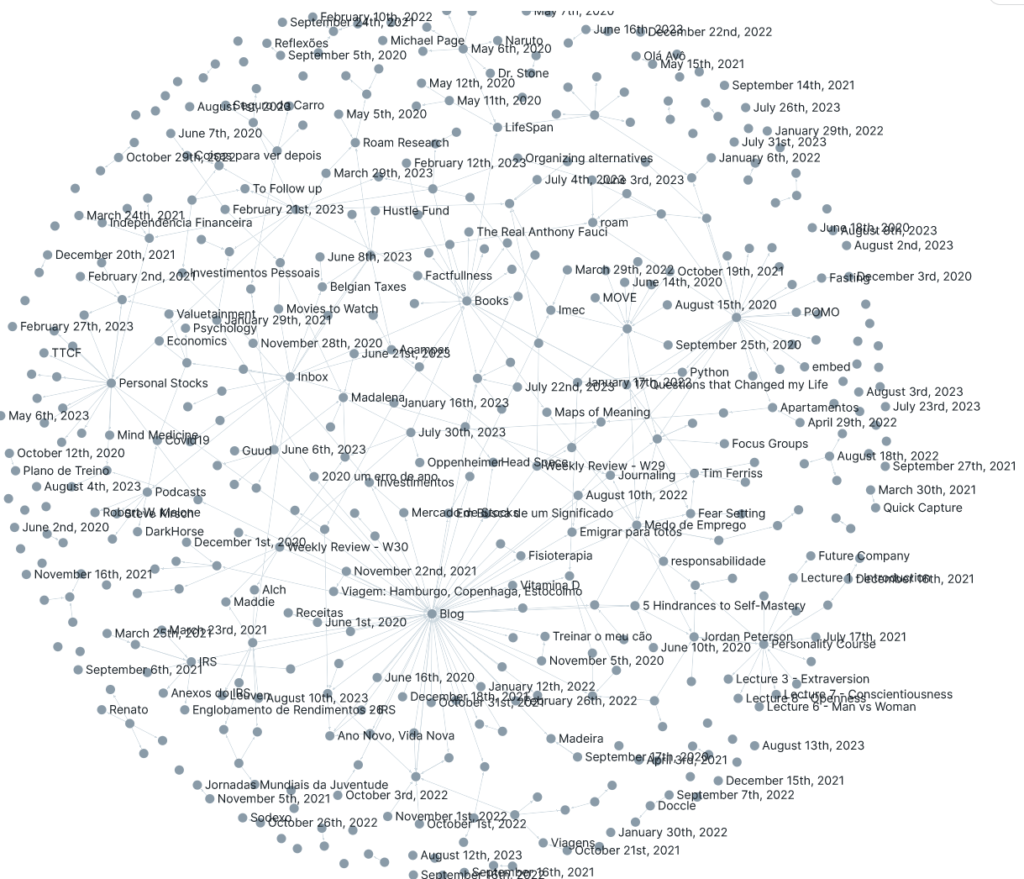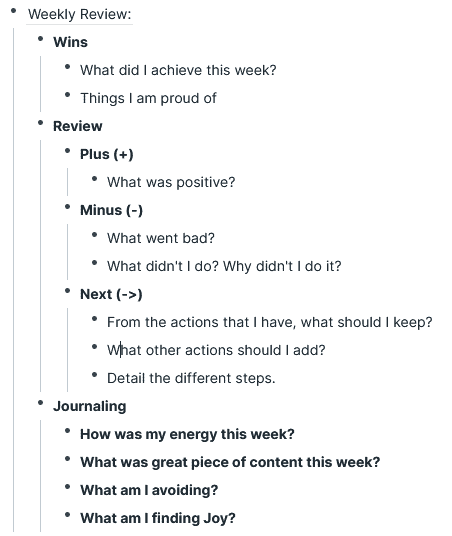Hey there!
Indice
Do you consider yourself organized?
What strategies do you use to organize yourself?
Do you feel unsure what to do next when you end a task?
Struggle to prioritize what to do next?
Feel like procrastinating with a lot of work to do?
Maybe this blog post can help you out a bit!
As my friends can tell you, I have a “small” predisposition to be disorganized. – Maybe that’s why I admire organized people!
Starting from high school, I tried different tips and tricks to organize myself, but I only felt the need to REALLY DO IT in 2020.
I started valuing my time – particularly regarding planning my future and working on my personal growth – with simple actions like journaling and goal setting.
Obviously, I would skip a few weeks, feel lost, return to the routine, and repeat…
Slowly I got better and more consistent at it. Tried out different methods to see what worked better, and especially when I was uncertain or lacking clarity in what to do, writing about it helped me out substantially.
But just journaling and drafting a plan is not enough, and since the beginning of 2023, I started feeling a bit frustrated and overwhelmed.
– Leaving tasks behind;
– Forgetting personal deadlines;
– Feeling like I didn’t have enough hours at work to do everything I wanted to get done.
The number of emails received grew, and I started taking on more responsibilities – but struggled to progress as I wanted.
In my personal life, I kept on dreaming I could pursue all Ideas in my head and turn them into something more, only to be paralysed by all the choices available each day. Even when I planned something, I don’t remember what I planned anymore, so I procrastinate -.-‘
-> And you might say: “This is not just an organizational issue” – Hey, I agree with you, but I needed to start somewhere! Remember, we have limited energy, and especially after 8h of work, no one wants to spend it making decisions… at least, I don’t xD
Something needed to change, and starting in April, I dove into different organizational systems.
- How to organize email;
- a calendar;
- a to-do list;
- integrate it with a note-taking app;
- what routines to follow;
- how to use the different apps;
- and much more.
I still have much to learn, but I got quite far in the last 4 months! This post is a review of what is working for me, and I hope it will inspire others to look into what works for them!
Remember that flexibility is one of the main advantages of using these tools. Each of us can tweak it to our needs. You can decide if my suggestions work for you or not 🙂
What I had to Start:
– I had a Note Taking System, both for my work – using OneNote – and for my personal life – using Roam Research.
– I had an email with a few rules set up – even though they didn’t work and all my inboxes were full. 😅
– I had a basic routine of reviewing my tasks and what to follow up. – it felt nice when I did it, but didn’t have the effect I wanted throughout the week/month/year.
I didn’t have a clear place to put my tasks – I wrote them in my paper journal for personal stuff and in OneNote at work. – Not very efficient… I frequently forgot to check back on them and ended up overlooking them.
What I wanted:
A Miracle!!
Since that is unlikely, I would settle with a good knowledge of how to use the tools I have, a system to collect information from various sources (youtube, books, podcasts, …) and a good routine to check my responsibilities and organize myself with the minimum amount of resistance!
Ok, let’s start:
EMAIL:
This is the first area I focused on. I had immediate actions to take, and it felt satisfying and liberating to see the inbox numbers going down!
Mistakes I made:
At work: I created too many rules and folders. The emails were going directly to specific folders (that I thought was smart) – but I ended up ignoring them. I kept all emails I did not want to forget in my inbox, but after 1 year, it was a big mess.
Sometimes I read emails 4/5 times to remember what I had to do -.-‘
At home: I created too many folders, didn’t use any and kept all my emails in the inbox. Eventually, emails got lost in the middle of the spam…
How to fix this?
I decided to achieve “Inbox Zero“! – If you’re unfamiliar with the concept there are Videos at the end of the post explaining it!
Main takeaways:
(Some of these tips are from a 3h training I did with Gunnar Michielssen about email, which was quite useful).
1- Minimalist inbox! 3 or 4 markers are enough – add it to your favourites – and use the minimum amount of rules possible.
– For work, I removed 50% of my rules on incoming emails.
Now, almost all emails go to the inbox – unless it is spam or something specific and repeatable. – and I decide what category they belong to.
I created 3 categories:
- “Follow up”;
- “Waiting Response”;
- “Read Later”
I also kept a bunch of different folders to archive information in a structured way.
– For home, I created 6 categories:
- “Follow up”;
- “Waiting Response”;
- “Read Later”;
- “Newsletters”;
- “Payments”;
- Official Documents”.
The last 3 have automatic rules for emails to go directly there.
2- Don’t take action on your emails right away.
– Before getting stuck in answering emails and entering firefighting mode, look at all the emails, and define what needs to be done for each of them and what takes priority.
Quick rules of thumb:
- If you can do it in 3/5 min, do it right away – no need to spend energy on it in the future.
- If not necessary delete it or archive it;
- If it is required info, add it to the “To Read” marker.
- If I need to wait for someone else’s input, add it to “Waiting Input”.
- If I need to take action on it, add it to “Follow up”.
Ideally, you use this in conjunction with a To-Do App, and when you send an action to “Follow up” or “To Read”, you create an action to go back and do that. – I’ll go over it in the next topic.
– It happened to me multiple times that I put the email in “Follow up” and forgot to check it. Since introducing the To-Do, it didn’t happen in 3 months!
3- Email is an asynchronous communication System – Use it mainly to communicate simple and not urgent information.
– Your email is not for storing Notes, not a task manager and not a calendar… Use each tool for what it is designed for.
– Turn off notifications and check email at fixed times defined by you(this will avoid unnecessary distractions.)
4- Create a “Never Again” folder – move everything from your inbox there. That way, you can start with a clean inbox.
– You will need to use that folder for 1 or 2 months, but afterwards, you only need to keep up the empty inbox 🙂
5- Write emails based on what the reader is looking for.
– Answer the Core question right away;
– Introduce paragraphs in between topics for better readability and information retention.
To-Do Apps
I use 2 apps. 1 for my personal life and one for work.
You might think having all these apps would cause even more confusion.
The opposite is happening! It is a quick and easy way – for me – to capture simple and complex activities with little effort.
I can move whatever I need to remember out of my head and into the app, which frees up my mental space for other things.
For work, I use Microsoft To Do:
It is simple to use and is integrated with Outlook and Teams – I can store emails in the To-Do or flag them to create a task. Then, I archive the email to keep the inbox clean ;).
Teams and Outlook also suggest tasks based on my emails and messages. And I can create different folders to organize what belongs to each project together.
For my day-to-day, I use Todoist:
It is basically the same with reduced complexity.
I only use the “inbox”, the “today”, and the “upcoming” folders.
I have recurring tasks like my Weekly review, exercise or cleaning. Besides that, I use it for simple stuff.
This is what my “Upcoming” tasks look like on the 16th of August 2023.
The goal is to keep it in my pocket instead of my brain. For more complex tasks, usually, I write them down there first, and later on, I change it to my note-taking app or the Calendar.
When cleaning up your email box and creating actions, try to be specific.
– Add some context and keywords like “Schedule”, “Review”, and “Plan”. If possible, set a due date, the app will notify you when it needs to be done, and you don’t need to think about it 🙂
Obviously, if you do this for all emails you have already stored, it will take a long time, and you’ll create too many “To-Do’s”. Two solutions for this:
- My strategy was to invest the hours, look at everything, put it all into tasks, prioritize what needed to be done first and follow it up. – It took me a few weeks to go through everything, and more than 100 tasks were created (I don’t think this is the most efficient way).
- The other Idea is “A Fresh Start”. Create a Folder called Never Again – like I said before – and only add the new actions from today onward.
Prioritize your tasks!
I like to have 3 levels of priorities:
– High – needs to be done this week.
– Medium – should be done this month.
– Low – something to keep in mind, but not urgent.
Besides the priority level, at work, I divide tasks according to their projects (especially at work) and I try to sort them by effort level as well. – Don’t put all the energy consuming tasks together xD
In summary – Out of your head, out of your email and into the app!
Note Taking App
Why is a note-taking app helpful?
As David Allen said: “Your mind is for having ideas, not holding them“.
You need a place to store all Ideas, Information and Projects you have and want to remember for the future!
For me, independently of the App, I look at it as a second brain. I’ll dump information there that I want to recall later on! – Credit to Tiago Forte here. The “Second Brain” Guru hehe
My personal and professional uses for it are quite different, so I’ll separate them here.
Personal Life: Roam Research
I use Roam Research for my personal note-taking. Chances are, you didn’t hear of it.
It is the best thing I have ever used! It completely fits my personality.
- I have no folders, just a blanket page where I can write what I want, tag Ideas, make new pages and connect all the information with keywords.
- I don’t even need to connect the information. It just does it by itself, either by me referring back to the topic or the Roam algorithm telling me I already made reference to it before.
I’ve been using Roam since 2020 to write my blog and store my knowledge and thoughts. It’s easy to access and acts like a neural network, connecting all my scattered ideas for me.
You can see how what I wrote links with things I write, and the App connects it for me!
It stores Ideas, articles/videos I watch, research for my blog, information on various responsibilities, journal, and weekly reviews and keeps track of my long-term projects.
I spent the last few months improving my Roam skills – through tutorials and reading articles – and I’ll keep using it even more in the next few years.
Work: One Note
I use One Note because everything is Microsoft based in my company, and all apps are integrated.
I can sort the information in Workbooks, Sections, Pages and Sub-pages.
It works well for what is needed for my job. I get to organize everything day by day, project by project…
It is not as intuitive to me as Roam – but I want to keep work-related separated from my personal life.
I am still figuring out the most organic way to organise my folders.
There is quite a bit of data I am unsure where to add – fearing I’ll forget where it is in the future… – But I’ll get there (eventually…).
General rules:
– Capture everything you think might be valuable.
This is a superpower, especially when you enter a new company and want to learn stuff asap.
You will not magically learn everything you see, but you can store it and search back when needed.
E.g. I have an issue with a process. The first time I need help to fix it. – I’ll take notes of what was done, link email threads where it was discussed and pictures I took if applicable.
Next time I face the same issue or something similar, I can go back to my notes and infer how to proceed. This will make you independent faster and help you out in situations where you are alone and need to come up with some solution ^^
Some things you will send to your calendar or capture on your to-do list. Not everything needs to be added here, but when in doubt, add it!
– Store data where you’ll need to use it!
I have the impulse to store data relative to where I found it – e.g. I have a folder called “Medium Articles”, and I put all the articles I read in Medium inside that folder. – I’ll probably forget about it.
Try to store it where you will need it. – In this situation, I can add it to the subject the article is about. e.g. “Productivity”, and when I want to read back about that subject, I have everything already organized there.
– Have a page for Templates!
Creating Templates for Emails, meeting minutes, weekly reviews, … will save you the mental energy of thinking about the structure when you need to make one!
You don’t even need to make the templates. Just copy your colleagues when they do something you like! ^^
My issue statement email is a copy of my boss’s. I received his email updating issues, liked it and copy-pasted the template to my One Note…
Same for my weekly review. I copied what a Youtuber suggested and added it to Roam Research.
– Have a Daily Page or an Inbox page.
Roam Automatically creates a Daily Page every day for me to start fresh. I like this feature, so I create a new page in OneNote as I get to the office. It is good if I want a timeline of process issues or to spot when I did something.
An Inbox page is also helpful. I can send Ideas and info there that I want to quickly capture and categorize when I do my daily/weekly review.
Personally, I don’t use it much yet. I have my Daily Page as my inbox. I am testing now using them separately. Not sure how it will work. xD
My Routine
You are probably thinking – This guy spends all his working hours planning what to do instead of doing stuff…
Well, it’s tricky. If you plan for the sake o planning, you are procrastinating. But, If you plan nothing, it is easier to procrastinate. Because when you end a task, you still need to decide what to do next. Decisions involve spending energy. Each extra decision will drain your energy and time. – Task switching is very inefficient. – If you plan ahead, you already know what needs to be done.
If I don’t plan to work on my blog or go to the gym, I get home after 8h of work and procrastinate. – Watching Anime/Youtube videos or playing a video game is easier to do and releases more dopamine xD
And nothing wrong with that! – If you want to. But if you wanted to do something else, like work on a project… afterwards you’ll feel guilty for not doing it.
So it will depend on the person. For me – with a bit of a chaotic personality – that structure is essential to get things done. – There are 2 ways for me to focus on something:
I either have a deadline coming, or I have it scheduled. If I don’t plan it, it seldom gets done.
My current routine:
– Personal life:
I do a weekly review of my life. This evolved during the last months from something I write down in my paper journal 1 time per week (it didn’t work) to writing every day in my paper journal (it didn’t work) to adding everything to my to-do list and revisiting it in my blog 1 time per week (working so far).
I write everything that might be useful in Todoist. On Fridays/Saturdays, I review it together with my email. I have a Template in Roam that I will leave down here…
I try to fill it up with whatever info I think is relevant.
Collect everything that was done/not done throughout the week and decide what I can focus on in the following 7 days.
For me, it works if I don’t over-schedule. I need time to breathe and go with the flow. – If I put in too many tasks, it’s not realistic -and I’ll end up procrastinating as well… (It’s a delicate balance xD)
Small things like “I need to buy cucumbers” or “Save Humanity from global warming”, are added to my to-do list.
Time-consuming activities are scheduled in Roam and then added to the to-do list. – Things like when to work on my blog, book holidays, read a book,…
– Work-life:
I review my emails and my to-do list first thing. Based on that information and the list of short-term issues, I define what my day will look like.
Other than that, I do a weekly review (preferably at the end of the week, but not always possible. Sometimes outside working hours…) where I check long-term actions more seriously, what’s the progress in each project, and how I should proceed in the following week – What do I need to do? Who do I need to bother?
It is easy to leave behind stuff with the day-to-day issues that come up.
I get paid to fix short-term issues that come up asap. – But the other assignments I work on are more challenging (and fun)!
So I need to deal with ongoing problems efficiently and determine what I can work on after I fix them.
Here I adapt a strategy similar to my personal life. I note down everything in my to do. Every email that needs an action longer than 3/5 min goes to my to-do (unless it is very urgent…), and then I sort out the priorities.
I pay a lot more attention to my calendar. It is filled with meetings, and I need to know when I can focus/make some tests vs when I don’t have much time and can do something else.
Also, maybe I want to schedule more meetings, reject some, add meeting notes, etc. – A calendar is crucial for work…
The integration between Outlook, Microsoft Teams, One Note and Microsoft To-Do is good. And for everyone working with these tools, a good understanding of them will save you a lot of time in the long run. I am still not a pro at it… but give me 2 more months. I’ll reach the level of proficiency I am looking for!
Also, about my routine, I turned off all notifications for my email and almost all for teams. It makes a big difference in your focus. I started doing it at the beginning of the month and felt the difference. I was afraid it would hinder my job (since I need to work on issues asap), but no!
I check both with enough regularity and stopping all interruptions by sounds and messages popping around on my screen did wonders for my focus.
Random Tips:
For newsletters or other stuff you want to read, I use Pocket (for Firefox) – You also have Instapaper – which saves online the page you want to read in the category you choose. Works as a Library for reading material. Quite cool.
If you want to start writing down more things and don’t know where to start, write what is on your mind. After you empty your head, things get more clear again 🙂
And I think that is everything I want to share this time!
It took me a while to gather all the information and put it in a structured way, but it helped me understand better all of it and make sure I implement it!
If you are curious about it, you can try some of the Tips I shared, and for extra info, please check out the videos and articles I added down below 🙂
Thanks for reading! See you next time!
Ricardo
Youtube Videos / Articles:
– Jeff Su talks about productivity in a relaxed way! Good if you want to get better at it, not go in-depth
From Apps, to resume tips or templates, he has everything presented in a digestible way.
Here are his videos about Inbox Zero got Gmail and Outlook!
– Leila Gharani knows everything about Microsoft apps!
I watch her mainly for Excel tips, but Outlook, OneNote, Power Bi, Teams… She has valuable videos for everything <3
Here is one of her videos about Microsoft To-Do.
– Thomas Frank is the YouTuber I have followed the longest.
I think he is taking a break now, but his videos are all about productivity. Entertaining, and useful, with complementary information in his blog for people that want to really research the topic.
Here is the video that introduced me to Roam Research. The Note-taking app I use the most.
– Finally, you have Tiago Forte. This guy is a machine.
If you want to go in-depth on all productivity topics, he is your guy.
He has a book all about how to build a second brain, and also a blog that is all about it. – He now has a new project called PARA (that I didn’t try yet, but sounds interesting.).
I’ll leave you with his playlist about his “weekly review” where he talks about everything he checks ^^
While I am at it, shout out to NessLabs. They have interesting articles related to productivity and organization! I’ll leave one about “The science of curiosity“.



